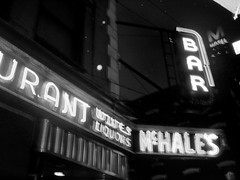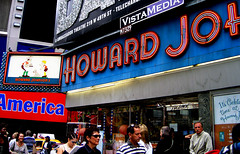South:264: Broadway Inn
Richard Rodgers Theater226: This 1924 design by Herbert J. Krapp was originally Chanin's Forty-Sixth Street Theater. Renamed in 1990 for the composer of Oklahoma!, South Pacific, The Sound of Music, etc. Guys and Dolls (1950) debuted here, as did How to Succeed in Business (1961), In the Heights (2008) and Hamilton (2015). 224: Was The Grotto, post-war Italian.
216: Was Dinty Moore's, a famous lunchroom which became a brand name for packaged stew. Described in 1940 as having "perfect American food at high prices." The place was made famous by the comic strip Bringing Up Father, where it was the title character's favorite eatery. Crusty owner Jim "Dinty" Moore once kicked playwright George S. Kaufman out for ordering a hamburger without onions, exclaiming, "I don't tell you how to write your goddamned plays and you don't tell me how to cook my hamburgers!" 210: Address of the old Helen Hayes Theatre, built in 1911 as the Folies-Bergere and later the Fulton, where Bela Lugosi played Dracula and Audrey Hepburn played Gigi. New York Marriott Marquis
Corner (1535 Broadway): When this glitzy mammoth was built in 1981-85—the first major new hotel in Times Square in 75 years—it destroyed five classic theaters: the Astor, Bijou, Gaiety, Morosco and the old Helen Hayes. (The Marriott did add one new theater—The Marquis.) This wanton destruction led to a wave of landmarking in the Theater District. The design is by John Portman, noted for similar hotels around the country. The facade of the hotel features a huge electronic sign for Bank of America, and an enormous ad for Kodak. In the movie True Lies, Arnold Schwarzenegger rides a horse on this building and almost falls off the edge. |
W
|
North:
Corner (750 8th Avenue): Platinum NYC is a 42-story glass-and-steel condo tower by Costas Kondylis, built in 2007. To build it they tore down McHale's Bar, a classic watering hole that dated back to 1944, when it was the Gaiety Cafe; the stainless steel exterior had been installed in 1941. The Platinum was able to add four stories to its height by buying air rights from the St. James, Al Hirschfeld and Brooks Atkinson theaters. Pastis Bakery Cafe is on the ground floor. Paramount Hotel235: This 1928 Thomas W. Lamb hotel was given a stylish makeover in the 1980s by Philippe Starck. There's a concert space in the basement called Sony Hall; starting in 1938, it was Billy Rose's Diamond Horseshoe nightclub, noted in the WPA Guide for its "elaborate show." Subsequently, it's been a burlesque venue, an iceskating rink and an off-Broadway theater. Since 2018, it's been a concert venue. Church of Scientology227: The religion started by sci-fi writer L. Ron Hubbard is housed in what was once the National Vaudeville Artists Club, where Cary Grant (then Archie Leach) lived while he tried to break into show biz in the 1920s. In the 1970s, the Seventh Day Adventists had their New York headquarters here. 225: Was Bal Tabarin, a nightclub noted in the WPA Guide for its "Montmartre atmosphere." 221: Sofia's 219: The Hotel Edison Cafe is noted for its Magic Table, where professional illusions gather to amaze one another. Lunt-Fontanne Theatre205: A Rococo palazzo built in 1909-10 by Carrere & Hastings as the Globe Theater. Sarah Bernhardt, Fred Astaire, Marlene Dietrich and Fanny Brice have played this stage. After the theater was renamed in 1958 for Broadway's leading acting couple, Lynn Fontanne and Alfred Lunt, they starred in The Visit here. The Sound of Music had its first long run here starting in 1959. In the Marvel series Hawkeye, Clint Barton sees Rogers: The Musical here. 201: Gaiety Male Burlesk was classic Times Square sleaze—seems to be closed now. It was also known as the Orpheum Dance Palace and the Kings Theater. Howard Johnson's
Corner: This was not only the last HoJo's in New York—it was one of the last in the entire country. Missed for its cocktails and Americana. It was once a Child's. Upstairs was the Gaiety, a gay burlesque house. Earlier it was the New Paris, with live sex shows; before that, from 1917-64, it was the Orpheum Dance Palace, New York's most famous dime-a-dance joint. Here in 1923, when it was known as Wilson's Dancing Studio, novelist Henry Miller met his second wife, June Mansfield. Rheba Brown, the Salvation Army's "Angel of Broadway" who was the inspiration for Guys and Dolls' Sarah Brown, used to hold her street rallies at this corner. |

